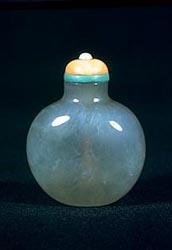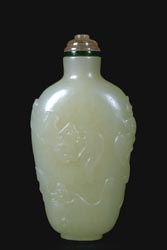Collecting and
Bribery - Chinese Snuff Bottles
A personal view by
John Neville Cohen
(as written for publication in 1995)
There is little doubt that the finest bottles were made in the reigns of Chien Lung 1736 - 95, Chia Ching 1796 - 1820 and Tao Kuang 1821 - 50. All Chinese artwork reached the highest of peaks during Chien Lung's reign thanks to his patronage and encouragement.
Luckily the taking of snuff had become very popular amongst the elite at an ideal time, so we have all the finest of the art forms superbly applied to the creation of snuff bottles.
There are some exceptions, but after Tao Kuang's death far too many bottles of indifferent craftsmanship have been made, right up to the present day.
What's in a Name?
Unlike most other great works of art, in collecting snuff bottles we have no artists' signatures. I use the term
'artist' deliberately rather than craftsman, for when studying the finest of bottles brilliant though the skills are, there is also superb artistry involved.
We are free to value and judge purely on the quality of the work, in many other art works we are greatly influenced by the name, often more so than by the quality. Just consider a doodle type sketch with the signature Picasso, it is worth a fortune, yet without that signature it would probably be unsaleable!
True, there are some bottles that are signed and dated, these being the
'Inside Painted' ones, but they represent a very small part of an enormous range of snuff bottles.
There is one other type of influence however and that is a genuine seal mark, especially if accompanied with
'By Imperial Command' although such a seal adds value it would also have to be an outstanding piece.
Etiquette Led to Desire
Taking snuff was not just a habit, but closer to a fashion in the way it was
practiced by the Manchus right up to the Emperor. Friends would exchange snuff when meeting in the street or at social occasions, but a number of etiquette rules were demanded. Rather like with the well known tea ceremony, where appreciation of the containers and the aroma were of great importance, so it was with snuff:- sometimes partaking a little of the snuff offered, otherwise just sniffing the aroma, but always paying a lot of attention to the bottle before returning it with a bow. There were many different types of snuff made by adding herbs and spices to the tobacco.
Great satisfaction was achieved when a coveted bottle was properly admired, and a lot of one-upmanship was involved. Each would desire to own the more impressive piece and as these were such small items it was not long before the first collections were formed.
Today too, much of the pleasure of owning these bottles is derived from discussion and shared appreciation. There is nothing quite like the delight and satisfaction of owning a superb piece especially when seeing the reaction of other knowledgeable collectors.
They were so sought after that although many were given as highly valued gifts, there are records of bottles playing a big part in bribery. Only a collector can know just how exciting and wonderful a bottle becomes, once you know that at last, it is about to become your own. I can well understand how effective bottles could be as bribes!
Ho - Shen
The Emperor Chien-Lung had his own collection, but his prime minister Ho-Shen, who at the time was the wealthiest man in the world controlling the opium trade, owned a huge collection of 2,390 bottles. He was a very dubious and corrupt character who demanded snuff bottles in return for almost anything.
What I find interesting is that here was a man of extraordinary wealth, who could have had the best of any of the types of bottles ever made, yet his collection was surprisingly confined to just stone and amber bottles. When one considers the variety of wonderful bottles he could have included, that we value so much still today, it is strange that he was not tempted by such beautiful glass, porcelain, enamel, lacquer,
cloisonn', ivory, bronze or inside painted bottles of which there were some phenomenal examples.
Our fascination with stone bottles that are still our favourites, especially the
'Picture Agates' that were the basis of our collection, did not stop us including many other types. Thinking back as to why we started to purchase other bottles, the motivation really was a desire to add more colours to our collection. When on display the stones alone lacked the brighter colours available in glass and porcelain.
The Need to Touch
I think this is an apt place to mention my personal views about collections in private hands as against museums. I am strongly in favour of private collection for certain tactile creations. A big part of the appreciation of items like netsuke, pendants, amulets and
snuff bottles is dependent upon being able to handle them as so much is lost if they remain locked away behind glass! It is much better for those who really desire them to pay for the privilege of being the guardians of these little treasures for a limited time.
The Stones
Ho-Shen favoured, as we do, the stone bottles so perhaps I should explain more about
jade, the most treasured stone of all to the Chinese. Jade has been highly prized by the earliest of civilisations, having far more value than gold. Sages of the past believed and related jade to all the virtues, as it was thought to protect and cure both physical and psychological ills, plus having the powers to endow one with wisdom.
The Aztecs of Mexico in 1500 BC and the Aboriginal Maoris of New Zealand all carved Jade as ornaments and weapons centuries earlier than the time of the white man. No one anywhere, before or since, has achieved the exquisite carving ability of the Chinese in the 18th century.
Jade was not found in China but brought in from Burma, although nephrite was found in the Kunlun mountains western China, but it is really a different stone. To the Chinese however, they considered and treated it as jade.
Both minerals are not easy to carve because of the crystal formation, as some areas are much harder than others are but both are extremely brittle although very hard rocks. A wide range of colours were found and used. The bright greens, white, yellow and
nephrite off-white called appropriately 'mutton fat' were all highly valued. Photographed is a prized bright emerald and yellow jade bottle of ovoid form that is well hollowed.

Many other stones were carved into bottles particularly the quartz type of minerals. These are the most abundant of all the rocks and make up a large part of the world's surface and are found in the form of many semi-precious stones such as
rock crystal, cornelian, chalcedony, smoke quartz and agate. All these varieties have been successfully used and feature in all good bottle collections. As an example I have illustrated a fine well hollowed bulbous quartz bottle with various crystalline inclusions that look like they are exploding! Other interesting bottles have been made from such minerals as limestone;
puddingstone formed in volcanoes, inkstone, soapstone and coral. Later,
malachite, turquoise, lapis lazuli, tourmaline, and aquamarine were also carved, although a few of these were carved earlier, they tend to be rather rare.

Inspection
So what do I look for when buying stone bottles? Personally the first thing I check is the weight, as I only buy really well hollowed bottles. The material must be attractive and the shape should also appeal. Make sure the bottle is in perfect condition; always have a good look at the neck and the foot of the bottle for any signs of damage. I also prefer one that has a good stopper and spoon that looks right with the bottle.
The next point is to be satisfied that it is stone and not a glass imitation, as there are some remarkable glass copies! If the bottle is also carved then the quality of that carving and the artistic composition are important considerations. The Chinese often would carve a bottle taking advantage of a natural flaw in the stone so cleverly, that it would appear as if the flaw was required to be there,
in order to improve the design!
Those illustrated are selected as good examples of the plain type of non-picture stone
snuff bottles. All are well hollowed, so much so that they would trap enough air to float in water. The
gray jade bulbous bottle looks more like a blown piece of glass and amazing skill is required to hollow out a hard stone this well, referred to as
'eggshell thin' and that is no exaggeration!

I have also shown a well-carved jade snuff bottle featuring the five bats. Bats are a good luck symbol for the Chinese and the five bats represent the five blessings of long life. These are wealth,
tranquility, and love of virtue, children and a natural peaceful death.

Of all the stone snuff bottles the picture agates are really our favourites. These are snuff bottles where the natural inclusions found inside the stone have been used to create pictures. There is so much to describe about these bottles that I have decided that they justify a separate article.
Lastly, I do not approve of any form of bribery, but as a keen collector
I confess that should anyone mention that a good bottle is on the market
they will have my immediate full attention!
John Neville Cohen, is a multifaceted photographic artist and collector, who defies categorization.
His creative endeavours span projection photography, where he
masterfully blends light and form, creating International award
winning photographs, to his passion for collecting Asian antiques
and classic Jensen cars. Additionally, he has contributed
interesting articles, and published 'The History of Jacey Cinemas',
a unique stamp collecting album for little people, apart from 'The
Trudy and John Neville Cohen Collection' of antiques. Have a look at
his 'Homepage' https://www.jncohen.net
To see other articles, with
photographs, please use the following link:
https://www.jncohen.com/_antiques/Articles/articles.htm
|
|
Keywords: Collecting,
bribery, John Neville Cohen, Collecting, Chien Lung, Chia Ching,
Tao Kuang, By Imperial Command, Manchus, snuff, Ho-Shen, glass,
porcelain, enamel, lacquer, cloisonne, ivory, bronze, inside
painted bottles, Pendants, Amulets, Snuff Bottles, Rock Crystal,
Cornelian, Chalcedony, Smoke Quartz, Agate, Inkstone, Soapstone,
Puddingstone, Coral, well hollowed, eggshell thin, Bats.
|



